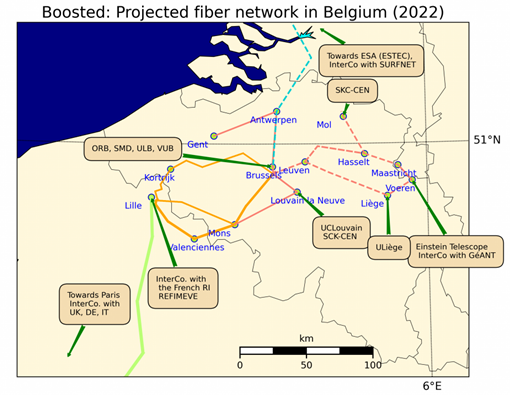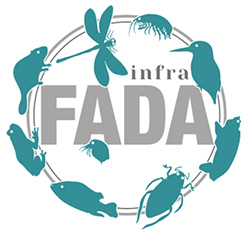ADVANCE: Antarctic bioDiVersity dAta iNfrastruCture (RBINS)
BE-QCI: Belgian-QCI (IMEC)
BlueBioBoost: Boosting seaweed farming through better utilization of genetic resources (EV-ILVO)
BOOSTED: Belgium Optical network for Optical frequency Standards and TimE Dissemination (KSB-ORB)
BopCo-Ce: Barcoding Facility for Organisms and Tissues of Policy Concern - Centre of Excellence (RBINS, RMCA)
BopCo-CE: Towards a Belgian Expert Centre for the Identification of Biological Specimens and Products of Policy Concern (RBINS, RMCA)
CANATHIST: The Natural History collections collected in central Africa by Belgian institutions (RMCA, RBINS)
CHrisis: Heritage in danger (RICH)
CoSo: Colonial Sources: Improve access, Share archives and Promote knowledge on the colonial past (Belgium, Burundi, the DRCongo and Rwanda) (RMCA, ARA-AGR)
DORA: Detection of Ozone Recovery in the Arctic (BIRA-IASB)
DOT: Database on Offender Trajectories (NICC-INCC)
DTO-TRACK: Digital Twin of the Ocean: Animal Tracking (VLIZ)
ENFORCE: Expertise centre for Forensic Wood Research (RMCA)
ExPoSoils: Climate change experiments in Arctic and Antarctic polar desert soils (UGent, ULiège, RBINS)
FROID: Finding the world’s oldest ice record around the Princess Elisabeth Station (ULB)
H-SEARCH: Heritage Science Elastic Archives (KIK-IRPA)
Hydrogen Test Facility for scientific and applied research (VKI)
infraFADA: Upgrading the taxonomic backbone of global freshwater animal biodiversity research infrastructures (RBINS)
LATTITUDE: Sleep at extreme latitudes: examining the differences between Antarctic and arctic environments (RMA)
LEANI: Low Energy Astrophysical Neutrinos in the Ice (UCLouvain)
LIFTHAW: Nutrient lift upon permafrost thaw: sources and controlling processes (UCLouvain)
LINAC@LNK: From nuclear waste characterization to medical metrology (SCK-CEN)
MAGSCREEN: Construction of a magnetically shielded room (KMI-IRM)
MetaBelgica: A shared entity management infrastructure between Federal Scientific Institutions (KBR, KMSKB-MRBAB, KIK-IRPA, KMKG-MRAH)
MPVAQUA: Floating solar at sea (RBINS)
NAMSAT: Natural hAzards Monitoring from SATellites (BIRA-IASB)
NEED: Needs Examination, Evaluation and Dissemination: identifying unmet patient and societal needs for a more needs-driven health policy and product development (KCE, Sciensano)
ORCHESTRA: ecOsystem Responses to Constant offsHorE Sound specTRA (UGent)
PASPARTOUT: Pathways of particles, VOCs and moisture into East-Antarctica in a changing climate (RMI, KU Leuven, UGent, ULB)
PROCHE: Provenance research on the ethnographic collection (RMCA)
PURE WIND: Impact of sound on marine ecosystems from offshore wind energy generation (RBINS)
Metis-Resolution: Metis-Resolution - phase 2 (ARA-AGR)
RESIST: Recent Arctic and Antarctic sea ice lows: same causes, same impacts? (RMI, UCLouvain)
SORBET: Services and OpeRability of the BRAMS nETwork (BIRA-IASB)
SUNRISE: Sustained and UNified Research Infrastructure for Solar data sErvices (KSB-ORB)
SURV-EMIS: Consolidating ship emission monitoring over the North Sea (RBINS)
ULTIMO: UnLocking The scIentific potential of the Belgica MOuntains, East Antarctica (VUB, ULB)






 infraFADA
infraFADA
